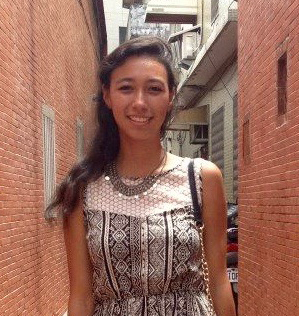2014-2015 INTERN: Ana-Alicia Feng

This past semester I had the pleasure of working as a Collections Management and Research intern at the University of Maryland Art Gallery. In the fall of 2016 I will be commencing my senior year at the University of Maryland, working on a double degree in Studio Art and Marketing. I undertook these two unique degrees together because I am interested in starting a career with visual arts administration, and the opportunity to intern at the Gallery complimented these majors and my professional interests.
During my first two years and a half at the University, I became familiar with the University of Maryland Art Gallery. I attended shows such as January 2015’s Reshuffling the Past: 2015 Contemporary Chinese Ink Art and fall 2015’s Questioning the Bomb: History and Non-proliferation and the 2015 Department of Art Faculty Exhibition. As an art-lover and student, the University of Maryland Art Gallery was a great opportunity to get involved in my field of interest and spread my passion for art to the students at the university. Through the internship I was also involved in the Gallery’s main exhibitions, such as Timeline: The University of Maryland Art Gallery at 50, Manhua + Manga, and the 2016 MFA Thesis Exhibition. For each exhibition I was able to help out with administrative tasks such as coordinating mailing lists as well as creating and hanging objects labels.
During my internship, I primarily worked with the Department of Art History and Archaeology’s African Art Collection, specifically the items from late professor Ekpo Eyo’s teaching collection, which had yet to be updated in the online cataloging system. I worked with the Permanent Collection Registrar and Graduate Assistant, Madeline Gent, to sort, photograph, and catalog each object. Working with Madeline taught me valuable skills for any future position in visual arts administration, including proper methods for archiving and researching works, as well as how to safely and securely handle, move, and store different types of art from the Gallery’s collection.
My semester culminated in developing and designing a project proposal. I wanted to build upon my work with the African Art Collection. I was also given the opportunity to use the Herman Maril Teaching and Research Gallery to realize my project. Because I am very interested in curatorial work, I chose to create a small exhibition of selected pieces from the collection. I decided to focus my project on masks because I noticed that over one third of the Gallery’s African Art Collection is composed of masks, headdresses and headpieces. Through this exhibition, I wanted to show that the masks shuffle back and forth between art and artifact. Also it was important to me to present how the works were a part of a larger and immersive experience.
I titled the exhibition, Looking Through the Mask to encourage viewers to take a different perspective of the art. The exhibition seeks to explore the cultural context and meaning behind these wearable art pieces, and how they represent more than just an aesthetic. Though these masks have fulfilled their spiritual purpose, they now serve as a commemoration to the culture, carvers, and performers that had the honor of interacting with these pieces.
Through working with this collection, I was able to apply the knowledge that I had learned two semesters ago in an art history class about some of the objects in the teaching collection. I wanted to choose pieces that were visually appealing, unique, and would intrigue the viewer past its aesthetics. At times it was hard to separate what I knew as the researcher and exhibition designer from what the public would see. I wanted people to understand these masks as much as I have without overloading the audience and the gallery wall with text. As the exhibition date approached, I found myself modifying my original proposal, adding a piece to the shelf and changing the overall layout so that the exhibition flowed more organically.
Although setting up the exhibition did not take as long as I thought, I had a lot of help not only from Madeline, but also from Taras Matla, the Gallery’s Assistant Director. Taras helped me figure out key installation details, such as trying to prop a mask upright while keeping a clean aesthetic. Madeline helped me cut the labels and served as an outsiders’ perspective while I was placing the masks in the gallery space. Designing the layout of the gallery space taught me that every detail counts, and that everything can be modified on the way. It almost seemed unreal when the exhibition was completely set up.
This exhibition will hopefully inspire more professors to take advantage of the teaching collection, as well as give students an insight to the Gallery’s permanent collection. It represents my time at the University of Maryland Art Gallery as well as my interests in a career of visual arts administration. Overall, this internship has built my network, shown me a new side to exhibitions that I had not yet explored, and taught me about museum work in depth that I doubt I could have gotten anywhere else during this semester. I will take these skills with me in the future as I pursue my career and education.

